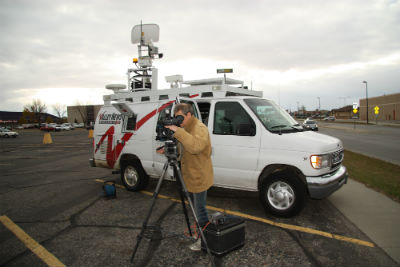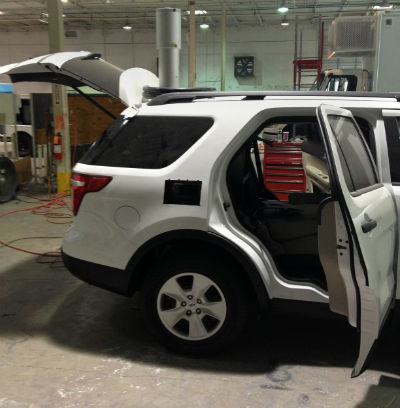Eye on ENG/SNG: ENG Trucks Roll Through Changing Landscape
ALEXANDRIA, VA.—There are a lot of television markets in the U.S., and not all of them are big. However, all of them have news programming, and this is a highly competitive activity regardless of the size of the markets.
So the question arose: How do smaller markets use their ENG resources to deliver competitive news programming? Is it different in DMA #165 (Missoula, Mont.) than it is in DMA #3 (Chicago)?
“The name of the game in any market is more trucks on the street for less money,” said Tom Jennings, president and vice president of sales for Accelerated Media Technologies in Auburn, Mass. “Regardless of market size, stations need a tool box full of tools, not one full of all hammers—it has to be equipped to win the story under any circumstance.”
KVLY videographer Nick Carlson sets up a live shot in South Moorhead, Minn., using the station’s Frontline ENG truck, PHOTO CREDIT: Lynn Trelstad Stations in smaller markets across the country face what may possibly be the greatest extremes in terrain and weather that exist in any country with significant television audiences. A good chief engineer takes the local terrain and weather into account when shopping for ENG vehicles, and that sometimes means outfitting your own vehicle to best meet the station’s needs.
KVLY and its sister station KXJB serve audiences from Fargo to Grand Forks, N.D. KVLY has two ENG trucks: one built by Frontline and the other built by the staff at KXJB.
“Our Frontline truck has the most equipment and the tallest mast, so that is our primary go-to live truck,” said Doug Jenson, chief engineer at KVLY in Fargo. “We have had it for nearly 14 years, with the only change being updating the microwave to Nucomm digital a few years ago.”

SIGNIFICANT TRAINING
Working at a station that sends its ENG trucks over a large geographic area with sharp weather events means that training is a significant activity. “We require that both operators as well as any news staff that ride in the live truck go through safety training,” Jenson said. “Our weather here is prone to high winds, lightning storms, freezing temperatures and other issues, all of which can require special action. Having everyone on a shoot aware of safety issues helps make decisions in marginal situations easier.”
Like many stations around the country, KVLY updated its Frontline ENG truck to digital as part of the BAS relocation project about four years ago. And like the staff at most stations, Jenson said that the change brought big benefits.
“Going to digital microwave was probably the best thing to happen to live remotes,” he said. “It allowed us to easily get into areas where we had a lot of problems previously.”
With the capabilities of digital microwave and the always-present desire to move news broadcasts outside, KVLY came up with a low-cost solution to show the ferocity of upper-Midwest winters.
“Last year, we started equipping one of our news cars with a portable microwave, mag-mount antenna, and a lipstick camera pointing out the windshield to show what road conditions are like during storms,” Jenson said. “We are adjacent to an Interstate, so we can point our central receive antenna down the road and get fairly long stretches of good video from a moving vehicle.”
NIMBLE AND RUGGED
Truck vendors respond to the needs of stations in smaller markets by pushing full ENG capabilities into more nimble and rugged vehicles. Rex A. Reed, director of business and product development for E-N-G Mobile Systems in Concord, Calif., said getting the shot can mean taking the gear off the beaten path.
“Being based in the west, we perhaps see more demand for 4x4 vehicles from all size markets, but especially so in smaller markets,” Reed said. “Weather is a huge concern and terrain does play a role—low ground clearance does not cut it when the pavement ends, so we see less demand for real small news gathering vehicles in smaller markets.”
Jennings at AMT sees the same demand for inexpensive but capable vehicles.
“Smaller markets typically have tighter budgets,” he said. “As we have migrated to smaller Ford Escapes, Transits and E250 vans, as well as Subaru Foresters, smaller markets have had an easier time swallowing the cost of adding trucks to their fleets.”
“We don’t see a significant difference in requirements between small-market stations and large-market stations, but we do see the smaller-market stations working harder to accomplish the same things but within tighter budget constraints,” said John Lunning, director of engineering for Shook Mobile Technology in Schertz, Texas. “This typically means they will be happy with an ‘ENG Lite’ as opposed to a standard-configuration ENG—less physical space, no equipment redundancy and limited production capability.”
At Shook Mobile, Ford Explorer gets modified for ENG operations. The mast is installed, and the dark rectangle above the wheel is a cutout for a connection panel Getting the story back to the studio is the primary function of the crew and vehicle, and chief engineers and truck builders understand that traditional microwave gear is not the only way to get a path to the studio. Everyone is on the same wavelength in this regard.
“The key for smaller and larger markets alike is aggregation,” Jennings said. “Aggregating cellular frequencies with microwave, WiFi, 4G, 3G and small Ku- (or Ka-) band satellite systems is the wave of the future—several small and inexpensive pipelines can be combined for extremely reliable and automated connection service.”

END OF THE LINE
Broadcasters who are now in long-term planning for new ENG trucks should be aware that vehicle manufacturers will be dropping some popular models and modifying others.
“There are some significant changes in the vehicle selections in the coming year that will affect news vehicle buyers,” Reed said. “The Ford E350 van will be discontinued in December 2014, and will be replaced by a U.S.-built version of the European Transit Commercial Van. Additionally, the 2500 [3/4 ton] Suburban is being dropped by GM in the immediate future. These are two mainstays of the broadcast market.
“Also, the smaller Ford Transit Connect that is being used in some markets will have a new design in 2013 that has a lower roof, presumably so that it will fit better into parking garages. Unfortunately, it was the high roof of the current design that made the vehicle a candidate for a news truck. 2014 will be a challenging year, as manufacturers retool and roll out new designs.”
However, as equipment gains new features and gets more compact, it’s possible to build an ENG vehicle today that looks more like other vehicles on the road and not a telltale boxy van.
“Smaller market stations sometimes provide a vehicle they have obtained through a marketing tie-in with a local dealer, or even just a great purchase deal,” said Ron Laurence, vice president of sales for Shook Mobile. “Consequently, we tell small-market stations to broaden their horizons when thinking about a new ENG vehicle... almost anything will work.”
Jenson said that KVLY has had a good experience with its two trucks, but that doesn’t mean they can do everything the station needs for the forseeable future.
“The trucks do a great job of getting us unique live events regularly,” he said. “Today if I were to start over, I would probably split my resources between one live truck and maybe one or two backpack cell units. The advantage of a cell unit is that it would allow us more coverage in some of our remote rural areas, as well as giving a reporter a rapid way to get on site and immediately send video back to the shop.”
Over the next year, some of the familiar designs for ENG trucks will disappear. At the same time, a modest revolution is growing with the use of 3G/4G backpacks and cellular connectivity.
Change can be scary, but it can also be good if it ultimately gives you more options and possibilities.
Get the TV Tech Newsletter
The professional video industry's #1 source for news, trends and product and tech information. Sign up below.
Bob Kovacs is the former Technology Editor for TV Tech and editor of Government Video. He is a long-time video engineer and writer, who now works as a video producer for a government agency. In 2020, Kovacs won several awards as the editor and co-producer of the short film "Rendezvous."

